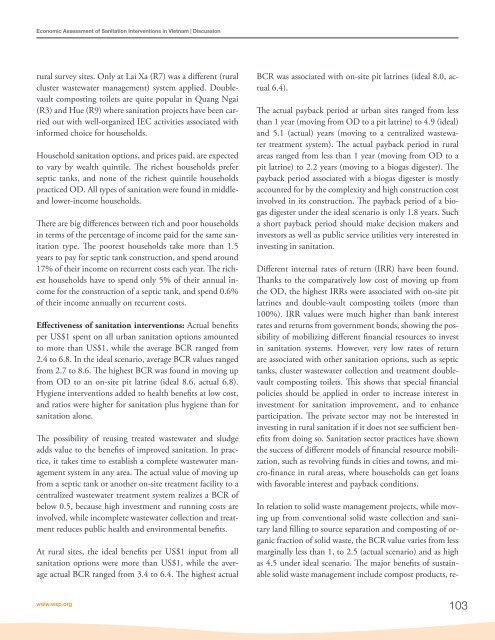Economic Assessment of Sanitation Interventions in Vietnam - WSP
Economic Assessment of Sanitation Interventions in Vietnam - WSP
Economic Assessment of Sanitation Interventions in Vietnam - WSP
Create successful ePaper yourself
Turn your PDF publications into a flip-book with our unique Google optimized e-Paper software.
<strong>Economic</strong> <strong>Assessment</strong> <strong>of</strong> <strong>Sanitation</strong> <strong>Interventions</strong> <strong>in</strong> <strong>Vietnam</strong> | Discussionrural survey sites. Only at Lai Xa (R7) was a different (ruralcluster wastewater management) system applied. Doublevaultcompost<strong>in</strong>g toilets are quite popular <strong>in</strong> Quang Ngai(R3) and Hue (R9) where sanitation projects have been carriedout with well-organized IEC activities associated with<strong>in</strong>formed choice for households.Household sanitation options, and prices paid, are expectedto vary by wealth qu<strong>in</strong>tile. The richest households preferseptic tanks, and none <strong>of</strong> the richest qu<strong>in</strong>tile householdspracticed OD. All types <strong>of</strong> sanitation were found <strong>in</strong> middleandlower-<strong>in</strong>come households.There are big differences between rich and poor households<strong>in</strong> terms <strong>of</strong> the percentage <strong>of</strong> <strong>in</strong>come paid for the same sanitationtype. The poorest households take more than 1.5years to pay for septic tank construction, and spend around17% <strong>of</strong> their <strong>in</strong>come on recurrent costs each year. The richesthouseholds have to spend only 5% <strong>of</strong> their annual <strong>in</strong>comefor the construction <strong>of</strong> a septic tank, and spend 0.6%<strong>of</strong> their <strong>in</strong>come annually on recurrent costs.Effectiveness <strong>of</strong> sanitation <strong>in</strong>terventions: Actual benefitsper US$1 spent on all urban sanitation options amountedto more than US$1, while the average BCR ranged from2.4 to 6.8. In the ideal scenario, average BCR values rangedfrom 2.7 to 8.6. The highest BCR was found <strong>in</strong> mov<strong>in</strong>g upfrom OD to an on-site pit latr<strong>in</strong>e (ideal 8.6, actual 6.8).Hygiene <strong>in</strong>terventions added to health benefits at low cost,and ratios were higher for sanitation plus hygiene than forsanitation alone.The possibility <strong>of</strong> reus<strong>in</strong>g treated wastewater and sludgeadds value to the benefits <strong>of</strong> improved sanitation. In practice,it takes time to establish a complete wastewater managementsystem <strong>in</strong> any area. The actual value <strong>of</strong> mov<strong>in</strong>g upfrom a septic tank or another on-site treatment facility to acentralized wastewater treatment system realizes a BCR <strong>of</strong>below 0.5, because high <strong>in</strong>vestment and runn<strong>in</strong>g costs are<strong>in</strong>volved, while <strong>in</strong>complete wastewater collection and treatmentreduces public health and environmental benefits.At rural sites, the ideal benefits per US$1 <strong>in</strong>put from allsanitation options were more than US$1, while the averageactual BCR ranged from 3.4 to 6.4. The highest actualBCR was associated with on-site pit latr<strong>in</strong>es (ideal 8.0, actual6.4).The actual payback period at urban sites ranged from lessthan 1 year (mov<strong>in</strong>g from OD to a pit latr<strong>in</strong>e) to 4.9 (ideal)and 5.1 (actual) years (mov<strong>in</strong>g to a centralized wastewatertreatment system). The actual payback period <strong>in</strong> ruralareas ranged from less than 1 year (mov<strong>in</strong>g from OD to apit latr<strong>in</strong>e) to 2.2 years (mov<strong>in</strong>g to a biogas digester). Thepayback period associated with a biogas digester is mostlyaccounted for by the complexity and high construction cost<strong>in</strong>volved <strong>in</strong> its construction. The payback period <strong>of</strong> a biogasdigester under the ideal scenario is only 1.8 years. Sucha short payback period should make decision makers and<strong>in</strong>vestors as well as public service utilities very <strong>in</strong>terested <strong>in</strong><strong>in</strong>vest<strong>in</strong>g <strong>in</strong> sanitation.Different <strong>in</strong>ternal rates <strong>of</strong> return (IRR) have been found.Thanks to the comparatively low cost <strong>of</strong> mov<strong>in</strong>g up fromthe OD, the highest IRRs were associated with on-site pitlatr<strong>in</strong>es and double-vault compost<strong>in</strong>g toilets (more than100%). IRR values were much higher than bank <strong>in</strong>terestrates and returns from government bonds, show<strong>in</strong>g the possibility<strong>of</strong> mobiliz<strong>in</strong>g different f<strong>in</strong>ancial resources to <strong>in</strong>vest<strong>in</strong> sanitation systems. However, very low rates <strong>of</strong> returnare associated with other sanitation options, such as septictanks, cluster wastewater collection and treatment doublevaultcompost<strong>in</strong>g toilets. This shows that special f<strong>in</strong>ancialpolicies should be applied <strong>in</strong> order to <strong>in</strong>crease <strong>in</strong>terest <strong>in</strong><strong>in</strong>vestment for sanitation improvement, and to enhanceparticipation. The private sector may not be <strong>in</strong>terested <strong>in</strong><strong>in</strong>vest<strong>in</strong>g <strong>in</strong> rural sanitation if it does not see sufficient benefitsfrom do<strong>in</strong>g so. <strong>Sanitation</strong> sector practices have shownthe success <strong>of</strong> different models <strong>of</strong> f<strong>in</strong>ancial resource mobilization,such as revolv<strong>in</strong>g funds <strong>in</strong> cities and towns, and micro-f<strong>in</strong>ance<strong>in</strong> rural areas, where households can get loanswith favorable <strong>in</strong>terest and payback conditions.In relation to solid waste management projects, while mov<strong>in</strong>gup from conventional solid waste collection and sanitaryland fill<strong>in</strong>g to source separation and compost<strong>in</strong>g <strong>of</strong> organicfraction <strong>of</strong> solid waste, the BCR value varies from lessmarg<strong>in</strong>ally less than 1, to 2.5 (actual scenario) and as highas 4.5 under ideal scenario. The major benefits <strong>of</strong> susta<strong>in</strong>ablesolid waste management <strong>in</strong>clude compost products, re-www.wsp.org103
















